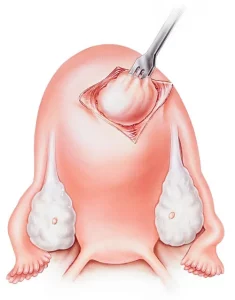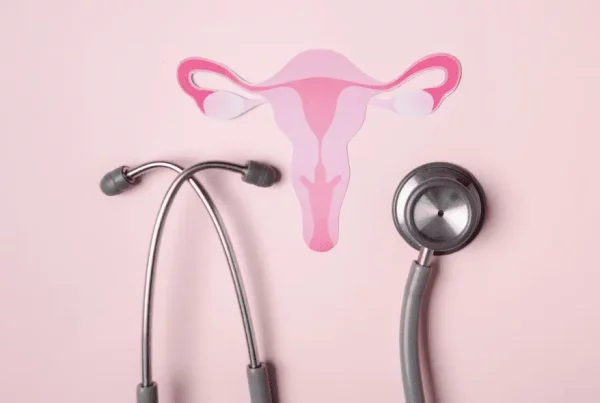Fibroids are a very common gynaecological condition. About 20% to 40% of women will develop fibroids in their lifetime. What else should you know about them as a woman?
What are Fibroids?
- Fibroids or uterine fibroids are smooth muscle tissue growths of the uterus
- It can also be referred to as a myoma, which is a slow growing benign tumour
- There is a less than 1% chance of this tumour developing into a cancerous growth
- Fibroids can grow in various parts of the uterus, including the cervix and broad ligaments
- Fibroids can either occur singly or in multiples within the uterus
What are the Different Types of Fibroids?
- Intramural fibroid: Found in the muscle of the uterus
- Submucosal fibroid: Found in the endometrium of the uterus
- Subserosal fibroid: Found on the surface of the uterus
What Causes Fibroids?
The exact cause of fibroids is unknown. However, certain risk factors have been observed to increase the occurrence of these growths.
- Genetics or family history
There is a higher chance of a woman developing fibroids if her mother or sister has fibroids.
- Ethnicity
There are certain ethnic groups that have an increased risk of developing fibroids, in particular, the Africans.
Fibroids usually grow during the reproductive age of a woman, when there are increased levels of estrogen and progesterone. When a woman reaches menopause and has low hormonal levels, the fibroids usually shrink. If fibroids are seen to increase in size after menopause, it should be investigated for any possibility of a malignant or cancerous fibroid, also known as a Leiomyosarcoma.
Could I have Fibroids?
The symptoms of fibroids are related to its size, whether it is single or multiple, and its location. For example, when the fibroids are small and/or present in the superficial layer of the uterus, you will usually not experience any symptoms.
Women with submucosal fibroids usually suffer from heavy menstruation, which may require them to change sanitary pads every hour. They could also be passing out large pieces of blood clots or have prolonged menstruation.
Other fibroids like subserosal fibroids typically do not cause any symptoms unless they become very big, in which case you might experience bloatedness and observe an increase in the size of your abdomen. (That’s not a tummy!)
If these large fibroids press on the bladder, you might be urinating more frequently or have a constant urge to urinate.

Can Fibroids Affect My Chances of Pregnancy?
- Fibroids typically do not cause infertility unless they are found to be obstructing the fallopian tubes, in which case, the sperm is prevented from meeting the egg to facilitate fertilization.
- Fibroids found in the endometrium may affect the implantation of the embryo, reducing the chances of pregnancy. There could also be a higher chance of a miscarriage.
- Some intramural fibroids near the womb lining could also affect uterine contractility and embryo transport.
Experiencing symptoms or suspect you may have fibroids?
Consult a Gynaecologist TodayFrequently Asked Questions
How can Fibroids be Treated?
Most fibroids do not need to be treated because they are usually small and do not affect the woman. However, if the fibroids are causing symptoms, treatment should be initiated.
The type of treatment will take into consideration factors like:
- Your age
- Family planning
- Number of fibroids
- Your priorities
Medical Fibroid Treatment
Symptoms like heavy menstruation can be treated with tranexemic acid (a medicine that helps to clot your blood) or hormonal pills. In some cases, a hormonal Intrauterine Device can be inserted into the uterus to reduce heavy bleeding. However, these methods only help to manage the symptoms and do not remove the fibroids.
GnRH Agonist injections are sometimes used to simulate a pseudo-menopausal state. This reduces the level of estrogen and causes the fibroids to shrink. However, this is only a temporary method as the patient cannot be receiving the injection permanently, especially if you are planning for a baby. This method is often used to shrink very large fibroids before surgery, hopefully by 50% so that they can be removed easily with a small incision to lessen the risk of bleeding.
New medications such as Selective Progestogen Receptor Modulators (SPRM) shows much promise in the treatment of fibroids. Initially used for pre-operative shrinkage of fibroids, studies have shown that they can be effectively used for long-term for up to 18 months and that the effect persisted for 3 months even after completion of the medication.
Ultrasound examinations can be done periodically by a gynaecologist to monitor the fibroids and their growth. If they increase in size significantly, surgery may be required.
Surgical Fibroid Treatment
- Hysteroscopy (Trans-Vaginal)
If the fibroids are present within the endometrial cavity, a minimally invasive procedure known as Hysteroscopy can be performed. A scope (hysteroscope) will be inserted into the vagina through the cervix into the endometrial cavity. The fibroids can then be cut out. Hysteroscopy is safe and can be done as a day surgery. As no incisions are made, there are no scars.
- Laparoscopic Myomectomy (Minimally-Invasive)
Laparoscopic myomectomy is a minimally invasive surgery where a few small incisions are made in the abdomen.Thereafter, thin surgical instruments are inserted to remove the fibroids. The recovery rate of this procedure is relatively high.
- Single Incision Laparoscopic Myomectomy
This is the least invasive form of laparoscopic surgery as there is only one incision in the belly button. The scar is hardly visible and therefore cosmesis and speed of recovery will be the main advantage of this form of surgery. Suitability for this procedure will depend on factors such as size, position and number of fibroids that are to be removed.
- Robotic Surgery
This utilises robotic instruments that follow the wrist and hand movements of the surgeon who operates at the console with 3D vision. As a result, the movements are intuitive and have the most maneuverability/ dexterity of any minimally invasive technology. Usually robotic surgery will provide an advantage in the deep pelvis where there is limited space and when a lot of suturing is required.
- Laparotomy (Open Surgery)
Not all fibroids can be removed through laparoscopic surgery. This is when laparotomy is used, when an incision is made on the lower part of the abdomen. With this method, the surgeon can remove large fibroids very quickly, and can also feel for fibroids that are buried deep inside the muscle of the uterus. Almost all fibroids can be removed via this method. However, as this is an open surgery, it cannot be done as a day surgery and the patient usually has to stay in the hospital for 3 to 4 days depending on her recovery. Open surgery also tends to leave a larger scar upon recovery.
Once the fibroids are removed during surgery, they are sent for a tissue (histology) examination where the pathologist will examine the fibroid tissue under a microscope and provide a diagnosis.
Your gynaecologist will then provide a review after your surgery.
Uterine Artery Embolisation (UAE)
This is a procedure performed to block the blood supply to the uterus and the fibroids. As a result, the fibroids are starved of oxygen and undergoes degeneration. The degenerated cells are absorbed by the body and the fibroids shrink in size. This procedure may not be suitable for those who desire pregnancy since potentially the blood supply to the uterus may be affected.
What if I'm Pregnant and have Fibroids?
- Fibroids generally do not affect pregnancy or cause harm to the baby.
- Majority of the fibroids seen in pregnancy are small and usually do not cause problems.
- However, there may be some big fibroids that could continue to grow as the pregnancy advances.
- If they become too big, they can cause pain and uterine contractions, which are not good, especially if the baby is not due for delivery.
- Right after delivery of the baby, fibroids may inhibit the contraction of the uterus, which increases the risk of massive bleeding.
- In such cases, it is essential for the obstetrician to be fully aware of the condition in order to anticipate potential problems and take preventive measures.






